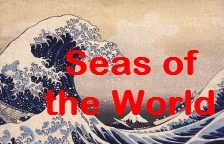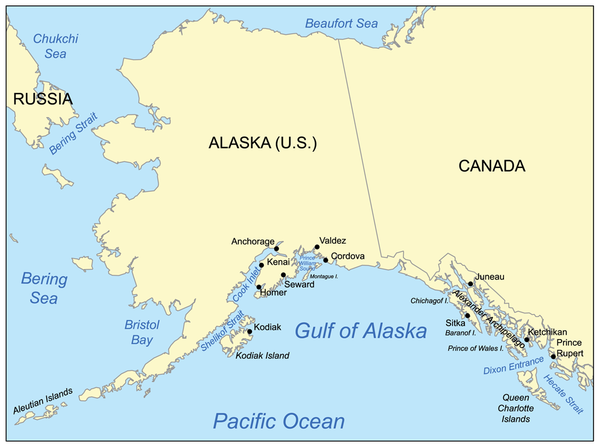Gulf of Alaska
Seas of the World  The Gulf of Alaska is a marginal sea of the western Pacific Ocean stretching along the Alaska Peninsula and extending east to Glacier Bay.
The Gulf of Alaska is a marginal sea of the western Pacific Ocean stretching along the Alaska Peninsula and extending east to Glacier Bay.
Within a sub-Arctic climate regime, this gulf has a very high level of biological primary productiviity; correspondingly, there are a number of rich fisheries within the Gulf of Alaska.
Contents
Geography and Hydrography
The Alaska Peninsula separates the Gulf of Alaska from Bristol Bay, which is an arm of the Bering Sea. The circulation pattern in the central Gulf of Alaska Basin consists of the anti-clockwise cyclonic Alaska Gyre, which is an element of the more extensive subarctic gyre of the north Pacific Ocean.
Climate
The climate of the Gulf of Alaska is a sub-Arctic environment. The climate of the North Pacific changes sharply over decadal periods of decades, centuries and millennia, in concert with larger climatic processes in other parts of the world, such as in the North Atlantic. In the fall to spring seasons there are prevailing low pressure systems in the western and southern regions of the Gulf of Alaska. This system is often called the Aleutian Low, and is an important forcing factor for the entire Northern Hemisphere. By contrast, these parts of the Gulf have characteristic high pressures dominating in the summer season.
Primary Marine Productivity
Climate is a driving force on plankton biomass production and plankton species composition. The Gulf of Alaska Large Marine Ecosystem is a Class I, highly productive (more than 300 grams of carbon per square meter per year) ecosystem based on SeaWiFS global primary productivity estimates. the primary productivity is linked to a significant upwelling phenomenon linked to the presence of the counterclockwise gyre of the Alaska Current. The Large Marine Ecosystem’s cold, nutrient-rich waters support a diverse ecosystem. Large-scale atmospheric and oceanographic conditions affect the productivity of the Gulf of Alaska.
There is a difference of view as to what causes changes in the eastern bifurcation of the Subarctic Current into the Alaska Current, and the possible cascade effects on biological productivity here. Changes in zooplankton biomass have been observed in both the Gulf of Alaska and the California Current Large Marine Ecosystem directly to the south. These biomass changes appear to be inversely related to each other (Brodeur et al., 1999). A well-documented climatic regime shift occurring in the late 1970s caused the Alaska gyre to be centered more to the east (Lagerloef, 1995). Brodeur posits changes in the future production of salmon as a consequence of long-term shifts in the plankton biomass in the last decades.
Fisheries
Fish and crustacean catch composition in the Gulf of Alaska large marine ecosystem is characterized by a strong prevalence of the freshwater and diadromous group, and rich salmon fishery (Fisheries and aquaculture). The Gulf of Alaska supports a diverse ecosystem that includes several commercially important fisheries such as Alaska pollock (Theragra chalcogramma), Pacific cod, mackerel, Alaska salmon, sockeye salmon, pink salmon and halibut. Production was 650,000 metric tons in 1990 and remained relatively stable over the ensuing decade. Crustacean species landed are king crab, tanner crab, and shrimp. There is fishing on an industrial scale in the Gulf of Alaska. The trawlers in the Gulf of Alaska continue to harvest untargeted species, some of which are not recovering from resultant overfishing.
Water Quality
Water pollution problems affecting the Gulf of Alaska LME include predation by invasive species (Alien species), discharges of oil products, and industrial and agricultural contaminants that enter the gulf through a variety of pathways (ocean currents, prevailing winds). Prince William Sound is routinely crossed by large oil tankers. In 1989 the Exxon Valdez, off of the Port of Valdez, the terminus of the Trans-Alaskan Pipeline, spilled 11 million gallons of North Slope crude oil. This was the largest tanker oil spill in US history and it contaminated 1500 miles of the Gulf of Alaska’s coastline. More than 10 years later there are concerns on the lingering effects of the oil spill and the pockets of residual oil in the environment, especially in the western portion of Prince William Sound. More common than spills, however, are smaller discharges of refined oil products, crude oil and hazardous substances
Terrestrial Ecology
See main article: Alaska Peninsula montane taiga
The Alaska Peninsula montane taiga ecoregion stretches along the southern, Pacific Ocean side of the Alaska Peninsula, from the mouth of Cook Inlet westward to (and including) Unimak Island. It also includes the majority of the Kodiak Island archipelago. Most of the ecoregion consists of rounded mountain ridges ranging between sea level and 1200 [[meter]s] (m) in elevation, but several steep, rugged volcanic peaks rise to 1400 to 2600 m. The slopes are covered by dwarf scrub communities on upper slopes and in exposed areas and low scrub in lower, more protected sites. The dwarf scrub plant communities are dominated by crowberry (Empetrum nigrum) and include other ericads (Vaccinium spp.), arctic willow (Salix arctica), and white mountain-avens (Dryas octopetala). Low scrubs are dominated by willows (Salix spp.), along with dwarf shrub species and some forbs. Tall scrub communities of alder (Alnus sinuata) and willow also occur in the lower elevations, and some floodplains and south-facing slopes support stands of balsam poplar (Populus balsamifera).
References
- R.D.Brodeur, B.W.Frost, S.Hare, R.Francis and W.James Ingraham, 1999. Interannual variations in zooplankton biomass in the Gulf of Alaska, and covariation with California Current zooplankton biomass, In: Large Marine Ecosystems of the Pacific Rim: assessment, sustainability and management, Q. Tang and K. Sherman, Blackwell Science, pp. 106-138. ISBN: 0632043369
- International Hydrographic Organization. 1953. Limits of Oceans and Seas, 3rd edition
- Phillip Roy Mundy. 2005. The Gulf of Alaska: biology and oceanography. Alaska Sea Grant College Program, Exxon Valdez Oil Spill Trustee Council, U.S.National Sea Grant Office. University of Alaska Fairbanks, Alaska Sea Grant College Program. 214 pages
- Taylor H.Ricketts. 1999. Terrestrial ecoregions of North America: a conservation assessment. Island Press. 485 pages
- Martha Shulski, Gerd Wendler. 2007. The climate of Alaska (Google eBook). University of Alaska Press. 216 pages
- United States National Oceanic and Atmospheric Administration), 2002. Large Marine Ecosystems of the world. U.S.Government Printing Office, Washington DC.
See Also
- Bering Sea
- Seas of the world

